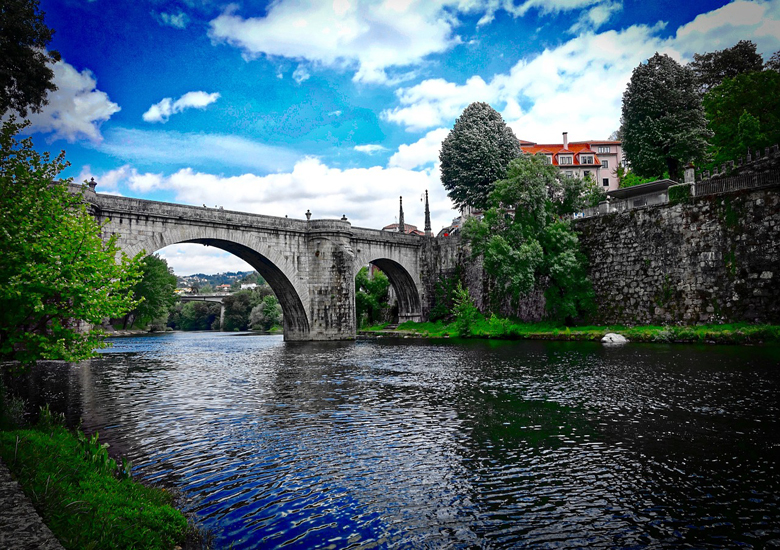Amarante is a municipality and municipal seat in the northern Portuguese district of Porto.
The population in 2011 was 56,264,in an area of 301.33 square kilometres (116.34 sq mi). The city itself had a population of 11,261 in 2001. Geography A view of the landscape of the town of Amarante in 1900. Amarante is situated in the agricultural lands of the Minho region, and belongs to the Porto district, region Norte and sub-region Tamega.
The Tamega River runs through the town and is crossed by a large arched bridge, the Ponte Sao Goncalo. It is reputed to have helped local forces fend off a French attack in the early 19th century. Nowadays the older centre of town is dominated by a multitude of cafes and restaurants dotted along the steep banks of the southern side of the Tamega River. Amarante is also associated with the tale of Saint Gonzalo/Goncalo de Amarante.
Architecture The monastery and bridges attributed and dedicated to Goncalo de Amarante
The architecture of the Amarante region is mainly in the Romanesque style, with a number of Romanesque monuments (colonnades, arches, tympana and columns) throughout the region. They were built in deserted areas or on crossroads on the outskirts of inhabited areas, serving as meeting places, accommodation and defensive positions. Amarante became part of the Sousa Valley Romanesque Route (Rota do Romanico) project on the 12 March 2010.
Access : Coordinates: 41.266667, -8.066667 / By airplane : The most convenient airports for Amarante are (in order of distance): Aerodromo de Vila Real – The small airfield of the neighboring city of Vila Real receives some flights from other cities of the country, but no international. Francisco Sa Carneiro Airport – Porto – Porto is served by Francisco Sa Carneiro Airport (IATA: OPO) – which receives frequent flights from major European cities including London, Madrid , Paris, Frankfurt, Amsterdam and Brussels, as well as some destinations within the country, such as Lisbon and Madeira / Funchal. TAP also has a daily direct flight from Sao Paulo and another from Rio de Janeiro.
Portela Airport – Lisbon – Portela International Airport is the largest Portuguese airport, and has air links with major cities in Europe and some of the Americas, Africa and Asia.
By train :
Going by train to Amarante, is at this moment impossible, due to the suppression of the line between Amarante and Livracao, which in turn connects to Porto. However, you can always enter the train in Oporto and do the rest of the bus route, since this is ensured by this means.
By bus :
The Bus Station is about 3 minutes from the city center. There are buses coming from various destinations all over the country and from there to so many others. Twice a day, all week, Rodonorte operates a bus service between Lisbon and Amarante, one at 11:00 and another at 6:00 p.m., for the price of € 18. In addition to these buses, Rodonorte also has buses from Porto (5 times a day at 07h00, 14h30, 16h30, 18h00 and 21h20, price: 6,40 €) and Viana do Castelo (Monday to Friday at 08h30 price € 10.80)
By car :
The best way to drive to Amarante is by using the A4 motorway if coming from Porto or the IP4 speedway coming from the North or Spain. Just take any exit in the direction of Amarante and it will be 5 min from the city center. The city is located about 1 hour from Oporto and 5 hours from Lisbon.
Important religious buildings can be found to the north of the Tamega, and include the Travanca monastery, the Mancelos church, the Teloes church, the Freixo de Baixo monastery and the Gatao church. On the southern side of the river, can be found the Jazente church, the Lufrei church and the Gondar monastery which are in a more modest style.
Highlights :
- Church of Salvador (Portuguese: Igreja Paroquial de Real/Igreja do Salvador/Igreja Velha)
Church of Santa Maria (Portuguese: Igreja Paroquial de Jazente/Igreja de Santa Maria)
Church of Sao Joao Baptista (Portuguese: Igreja Paroquial de Gatao/Igreja de Sao Joao Baptista) - Convent of Sao Goncalo de Amarante (Portuguese: Convento de Sao Goncalo de Amarante/Camara Municipal de Amarante/Museu Municipal Amadeo de Souza Cardoso)
Monastery of Divino Salvador (Portuguese: Mosteiro do Divino Salvador/Igreja Paroquial de Freixo de Baixo/Igreja do Divino Salvador) - Monastery of Gondar (Portuguese: Mosteiro de Gondar/Igreja de Santa Maria/Igreja Velha)
- Monastery of Lufrei (Portuguese: Mosteiro de Lufrei/Igreja Paroquial de Lufrei/Igreja do Divino Salvador)
- Monastery of Mancelos (Portuguese: Mosteiro de Mancelos/Igreja Paroquial de Mancelos/Igreja de Sao Martinho)
- Monastery of Teloes (Portuguese: Mosteiro de Teloes/Igreja Paroquial de Teloes/Igreja de Santo Andre)
- Monastery of Sao Salvador de Travanca (Portuguese: Mosteiro de Sao Salvador de Travanca/Igreja Paroquial de Travanca/Igreja do Divino Salvador)
Go next : Vila Real / Chaves / Douro valley / Lamego / Porto / Guimaraes / Braga.

